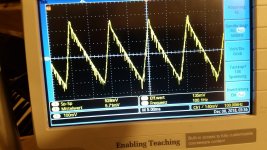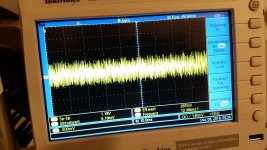That's a crazy amount of noise to see.
You should only be seeing around a volt of so of ripple on the main unregulated 44v rail that feeds this regulator. You need to see what is showing across C601, the main 10,000uF cap.
Ripple there is 0.5 Vpp with some amount of noise
An externally hosted image should be here but it was not working when we last tested it.
0.5v sounds good.
So something is going wrong around the regulator, and 9v of noise is just so massive that I wonder whether there is something more going on here like open or damaged print. You need to do some more careful measurements around this area.
You have more noise coming out of the reg than going into it.
Try attaching your pictures directly directly the last one wont open at all and just gives a 404 error.
the last one wont open at all and just gives a 404 error.
How to attach images to your posts.
So something is going wrong around the regulator, and 9v of noise is just so massive that I wonder whether there is something more going on here like open or damaged print. You need to do some more careful measurements around this area.
You have more noise coming out of the reg than going into it.
Try attaching your pictures directly directly
How to attach images to your posts.
Attachments
That works 
If that is across the 10,000uF cap and is around 0.5 volts pk/pk then that is OK.
Collectors of Q603 and 604 also connect to this main reservoir cap and so you should see the same level of ripple on those.
The emitter of Q604 should be absolutely clean and a straight line.
(I'm not sure what the random noise superimposed on the trace is and I wonder if it is actually some artefact of the scope/measurement set up)

If that is across the 10,000uF cap and is around 0.5 volts pk/pk then that is OK.
Collectors of Q603 and 604 also connect to this main reservoir cap and so you should see the same level of ripple on those.
The emitter of Q604 should be absolutely clean and a straight line.
(I'm not sure what the random noise superimposed on the trace is and I wonder if it is actually some artefact of the scope/measurement set up)
(I'm not sure what the random noise superimposed on the trace is and I wonder if it is actually some artefact of the scope/measurement set up)
I think thats part of the problem.... But I don't know whether it is the beginning of the problem or just a consequence...
Last edited:
Do you see that noise if you short the scope probe tip to its ground wire (you shouldn't see anything but a straight trace) and then touch the probe tip (while still connected to probe ground) to the ground line in the amp. Again, it should be noise free... but is it ?
absolutely noise free...
I better just add that if the scope is mains grounded and if the amp is mains grounded then you must NEVER connect the scope probe ground lead to any other point in the amp other than the amplifier ground.
To do so would short out to ground (via the equipment mains ground leads) the point you clipped the probe ground to... if that makes sense.
To do so would short out to ground (via the equipment mains ground leads) the point you clipped the probe ground to... if that makes sense.
I better just add that if the scope is mains grounded and if the amp is mains grounded then you must NEVER connect the scope probe ground lead to any other point in the amp other than the amplifier ground.
To do so would short out to ground (via the equipment mains ground leads) the point you clipped the probe ground to... if that makes sense.
I did not connect the scope to mains ground, I use a plug which omits mains ground for the scope. the amp isn't grounded at all, altough it has a metal case.......
absolutely noise free...
Very strange then. I say that because those spikes on the trace represent pretty instantaneous changes in voltages which wouldn't be easy given the caps size... and the voltage always seem to come back to where it was... which it wouldn't until the next charging cycle occurred.
It still just looks more like a measurement or equipment artefact tbh.
It still just looks more like a measurement or equipment artefact tbh.
But then I would have these artefacts everytime I use my scope. And I use it quite often......
And the amp was brought to me by a friend. He complained about the noise on the output, which it had not before....
But coudn't it just be one of these transistor gone noisy?
Last edited:
I've no answer at this stage I'm afraid. The noise on the 10,000uF doesn't look real as I say.
I'll have to leave it for just now but one thought... if the noise is real then (I think... I don't use a digital scope myself) it would remain unchanged as you alter the scope sweep frequency and sampling rate (apart that is from what you would expect to see changing sweep speed). Its all to spiky to be happening across a massive cap imo.
Do you see that same kind of spiky noise across the speaker terminals?
Do you see similar noise across Zener D603 in the regulator? That reference voltage should be very stable and smooth.
The only quick test I can think of would be to look at the noise across another reservoir cap in a different amp and see if you get the same spiky result.
I'll have to leave it for just now but one thought... if the noise is real then (I think... I don't use a digital scope myself) it would remain unchanged as you alter the scope sweep frequency and sampling rate (apart that is from what you would expect to see changing sweep speed). Its all to spiky to be happening across a massive cap imo.
Do you see that same kind of spiky noise across the speaker terminals?
Do you see similar noise across Zener D603 in the regulator? That reference voltage should be very stable and smooth.
The only quick test I can think of would be to look at the noise across another reservoir cap in a different amp and see if you get the same spiky result.
Thanks a lot for all your inputs. I see now what you mean. Unfortunately I just sold my analog scope....
I could be that these spikes have someting to do with the Internet signal on the mains (I am using Devolo Powerline). I can disable it and see what happens.
Probably I am just going to exchange the transistors after which the noise occurs and then see what happens....
BTW Thats the noise on the speaker terminals:
I could be that these spikes have someting to do with the Internet signal on the mains (I am using Devolo Powerline). I can disable it and see what happens.
Probably I am just going to exchange the transistors after which the noise occurs and then see what happens....
BTW Thats the noise on the speaker terminals:
Attachments
Last edited:
That would be a crapton of noise.
For a test, could you connect both probe terminals to just the - output?
In theory, you should then be seeing no signal.
If you still see major signal, your measurement setup is ground loop city. Which is quite possible since the 8000A appears to sport a 3-prong IEC jack, so it may be an IEC Class I device, just like the DSO (most scopes, actually). Unbalanced connections are inherently flawed in this case.
PS: For minimum noise from powerline ethernet solutions, make sure that your mains is squeaky clean, and that phases are appropriately (RF) coupled where necessary. It may seem ironic, but this stuff is super sensitive to SMPS noise and such, and will crank up RF output when SNR is not good. If I had to use it, I would pull out a portable shortwave receiver to identify troublemakers and stock up on mains filters.
For a test, could you connect both probe terminals to just the - output?
In theory, you should then be seeing no signal.
If you still see major signal, your measurement setup is ground loop city. Which is quite possible since the 8000A appears to sport a 3-prong IEC jack, so it may be an IEC Class I device, just like the DSO (most scopes, actually). Unbalanced connections are inherently flawed in this case.
PS: For minimum noise from powerline ethernet solutions, make sure that your mains is squeaky clean, and that phases are appropriately (RF) coupled where necessary. It may seem ironic, but this stuff is super sensitive to SMPS noise and such, and will crank up RF output when SNR is not good. If I had to use it, I would pull out a portable shortwave receiver to identify troublemakers and stock up on mains filters.
That would be a crapton of noise.
For a test, could you connect both probe terminals to just the - output?
In theory, you should then be seeing no signal.
Absolutely clean.
Odd. Could you take a spectrum of the noise?
So this is affecting both channels equally, right?
I would have a look at the +30V and +10V supplies there. The most likely component to make them go noisy would be C610 (470µ/16) having gone open - if a few hundred µF in parallel substantially reduce noise, that cap is dead.
Even then you should not be getting wideband white noise though, unless all the filter capacitors (e.g. C303/304) had suddenly gone bad, which I doubt. This rather smells like ground contamination to me. There are C103/104 with a low-impedance path to +10V, for example. This would mean, however, that there is a bad ground return from the preamp section somewhere - some poking around with the multimeter in ohms mode is advised.
(The schematics I have are for a model 207, I hope this matches your amp.)
So this is affecting both channels equally, right?
I would have a look at the +30V and +10V supplies there. The most likely component to make them go noisy would be C610 (470µ/16) having gone open - if a few hundred µF in parallel substantially reduce noise, that cap is dead.
Even then you should not be getting wideband white noise though, unless all the filter capacitors (e.g. C303/304) had suddenly gone bad, which I doubt. This rather smells like ground contamination to me. There are C103/104 with a low-impedance path to +10V, for example. This would mean, however, that there is a bad ground return from the preamp section somewhere - some poking around with the multimeter in ohms mode is advised.
(The schematics I have are for a model 207, I hope this matches your amp.)
If the noise you show across the speaker terminals is around 1 volt pk/pk (500mv/div... yes) then that would be pretty loud.
Is it?
yes it is clearly audible
- Status
- This old topic is closed. If you want to reopen this topic, contact a moderator using the "Report Post" button.
- Home
- Amplifiers
- Solid State
- Audiolab 8000a Background noise/hiss


